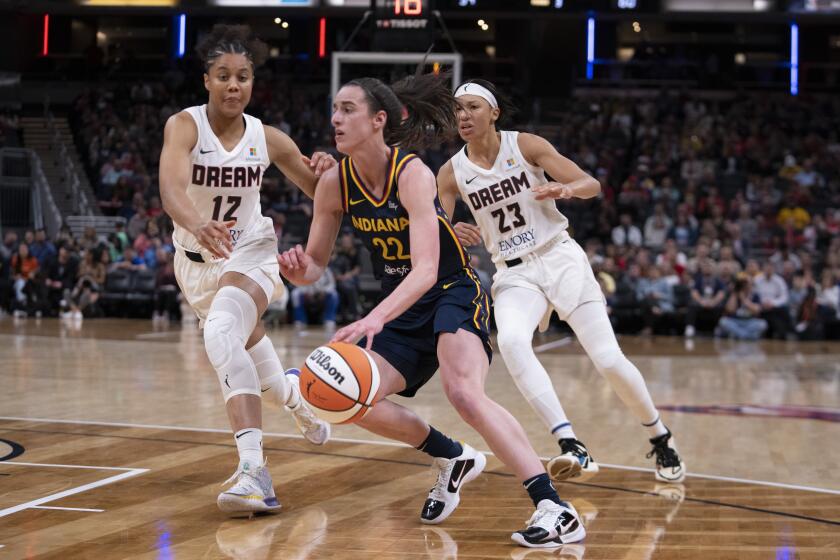Without Football, Brown Tries to Get on With Life
Reggie Brown was in his 10 a.m. calculus class when the frustration seized him with a frenzy. There was a quiz that day, and he had studied the night before, he really had. Still, his mind would not obey him. He looked at the first page and remembered nothing. He left it blank, turned the page, looked at the next page and felt the same empty sense of . . . nothingness.
He got angry then. He got into his truck, and pulled out on Highway 6, his back to the campus of Texas A&M; University, the road stretched out before him, stretched north to Austin, headed toward his home town. And even that didn’t seem right.
“I’m not supposed to be here,” Brown thought, and the words railed in his head. He thought about his old football team, the Detroit Lions, now in camp without him. He thought about the test that he wanted to tear into a million little pieces and all the time he’d spent studying, and all the little things that just felt wrong about his life.
“You’re supposed to be at training camp,” the voice screamed inside him, gripping Brown with a fierce measure of frustration. “Why aren’t you in your playbook? Why aren’t you in the heat right now, working with the other guys? Why? Why? Why?”
That said, Brown never made it to Austin that morning. He never made it more than a few miles before he turned his truck around and headed back to the campus that was his home before he joined the Lions and is his home again now. And he soothed the voice the only way he knows how.
“Yeah,” he thought to himself, “I’m not supposed to be here. I’m supposed to be in a training camp. I’m supposed to be in training camp
Reggie Brown is supposed to be at Saginaw Valley State University in Saginaw, Mich., at training camp with the Lions. He’s supposed to be lining up at linebacker, dripping sweat in twice-a-day practices, getting ready for his third season in the NFL. He’s 23, and he’s supposed to be on a college campus, all right, but he’s supposed to be eating with his buddies Bryant Westbrook and Richard Jordan and Kevin Abrams in the Saginaw Valley cafeteria, moaning with them about the uncomfortable dorm beds, dreaming with them about the start of the season.
There will be no football for Brown this September. Training camp has gone on without him. On that July morning when Brown went to his calculus class, one of two courses he enrolled in for Texas A&M;’s second summer school session, Allen Aldridge lined up at Brown’s old position for Detroit, trying to nail down a starting spot on a new team.
The Lions signed Aldridge last winter, when Brown still was in the rehabilitation hospital, learning to walk all over again. They signed Aldridge when Brown was struggling to grip a thick piece of white chalk and write his name on a blackboard, when his mother, Elizabeth, still felt compelled to hide her fearful tears in the hospital hallways, and when there were only two certainties about Reggie Brown’s future: He would live, and he would never play football again.
Football ended for Brown on, of all places, the football field. It was the last game of the 1997 regular season, a big game, a nationally televised game, a “regular soap opera of a game,” Brown likes to say. New York Jets Coach Bill Parcells needed to beat the Lions that day so that his team would make the playoffs in his first season as head coach and self-appointed savior. The Lions needed to beat the Jets if they wanted to make the postseason themselves. And Lions running back Barry Sanders, the player Brown worships even though he’s known him as a teammate, needed 131 yards to reach the magical 2,000-yard rushing mark for the season.
The excitement was so thick that day, Brown still can remember it. Oh, it was a game. So many things to watch, so many story lines to follow, so much at stake for so many. Brown can remember thinking, “This is what football’s about. This is it .” He can remember wondering how it would all turn out. He never expected that he would be at the center of the game clip that was played over and over and over on the news that night, and the next day, and the next.
It was a simple play, a standard play, but isn’t that how it always happens? On the road to the office you take every morning? Or skiing down the same slope you’ve skied since you were 12? Or, in Brown’s case, making the same tackle you’ve made since your arms were big enough to clasp around another boy’s waist.
Brown was assisting Antonio London as they tackled the Jets’ Adrian Murrell. The Jets’ Lamont Burns was in the mix, too, and as he fell over, the back of his 300-pound body collided with Brown’s helmet. Brown crumpled to the ground, and he did not get up.
For everyone but Brown--whose eyes were shut, his breathing temporarily stopped--the next several minutes advanced in slow motion. Brown was surrounded by doctors, loaded onto a spinal board, and placed into an ambulance as the crowd watched with fearful whispers. Players from both teams knelt in head-bowed prayer. Corey Raymond tucked a prayer card against his teammate’s motionless body before the ambulance doors closed. Up in the broadcast booth, someone told Paul Maguire, the television announcer, that Brown was dead.
“It looked so routine,” said Brown, who has watched the video replay again and again and again. “I mean, I’ve hit so many people, so many times.”
One in five people die from the type of trauma Brown suffered to his spinal cord, according to Brown’s doctors. Many spend the rest of their lives hooked to a respirator. Many more never walk again.
Brown walked a few weeks after the doctors at Detroit’s Henry Ford Hospital fused his first two cervical vetebrae in a surgical procedure meant to minimize the damage. They were little steps, baby steps, that took him maybe 20 yards down the hall.
Less than three weeks later, Brown was flown to Houston, nearer to home, and entered the Institute for Rehabilitation and Research. He spent one week there, one week in a place where most patients move in plants, and family pictures, and real clothes, and all the little things that make life less scary during what is often months and months of slow, painstaking, recovery.
Brown didn’t bother. He wandered up and down the hallways, making huge strides almost hourly, the medical staff eager for his autograph not because he was their football star patient, but because he was simply their star. Brown was their walking--walking!--miracle man, a player in the top 2 percent of the spinal cord recovery class.
“I was too advanced,” Brown said, the pride evident. “The (doctors) were working with people trying to walk, and there I was strutting around with my halo on my head.”
Brown left the hospital wearing the halo--a heavy brace attached to his skull by screws and designed to hold his head, neck and spine in place--but by St. Patrick’s Day, even that was gone. By spring, he was playing pick-up basketball and using the facilities at the weight room at Texas A&M;, where he returned to be with his girlfriend, A&M; basketball player Kerrie Patterson, whom he met before he left College Station for the NFL in 1996.
He cannot lift the weights over his head, because it’s too dangerous. And he can’t turn his neck from side to side to check his blind spot while driving, forced instead to turn his shoulders to look. His hands and feet have a residual numbness--he can feel hot and cold, but surfaces all seem to have the same texture, the rough fabric of his jeans no different to his touch than the softness of his skin beneath.
To Brown, though, these feel like little things. He’s far removed from the days when he had to concentrate just to pick up a spoon and eat his cereal, from the time when the doctors worried that he might never be able to walk right again. The physical fight is over, at least for the most part. And now comes the hard part. Now comes the time when Brown must find a way to heal the hurt inside his heart.
More to Read
Get our high school sports newsletter
Prep Rally is devoted to the SoCal high school sports experience, bringing you scores, stories and a behind-the-scenes look at what makes prep sports so popular.
You may occasionally receive promotional content from the Los Angeles Times.






